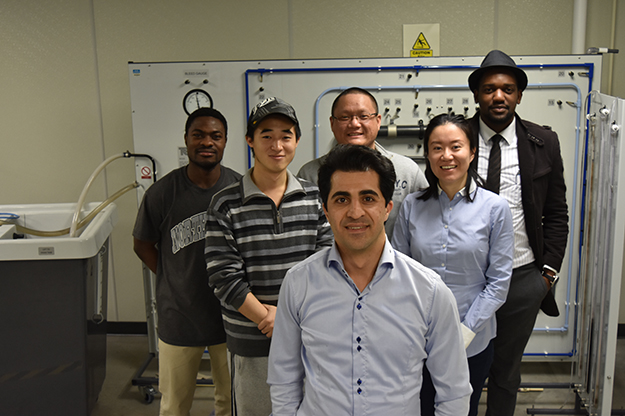Injecting more life in the Bakken
UND research developing better extraction methods to prolong lifespan of one of the world’s largest oil reserves

North Dakota is home to the Bakken Formation, among the world’s most fascinating—and challenging—petroleum reservoirs.
But like most other reservoirs around the world, the Bakken already has surrendered the stuff that’s easy to get at. Now comes the hard work of producing the oil that’s locked up in a tight liquid-rich formation or shale that resists most attempts at meaningful production.
Researchers at the UND Department of Petroleum Engineering are digging deep into this challenging resource and developing ways to get more oil out—part of a host of strategies collectively called Enhanced Oil Recovery, or EOR.
“It’s a big deal for North Dakota,” said Hadi Jabbari, a native of Iran and one of the first alums of UND’s recently launched petroleum engineering doctoral program. “We are working with industry partners and the state to recover much more oil from the Bakken.”
Three stages
Experts agree that as much as half the remaining global oil in the ground—what’s called “oil in place”—is locked up in rock that won’t readily release it, like the Bakken. That’s why researchers like Jabbari are figuring out how to get those rocks to give up that crude.
Oil in conventional reservoirs is recovered in three stages.
The first is where the easy money comes: punch a hole into the reservoir, install a well, and the crude gushes out. But that accounts for 25 percent or less of the recoverable petroleum.
The second stage uses pressurized water or gas to drive the oil out. That will bring up 10 to 20 percent more of the oil in place.
“But it’s a different story in ultra-tight unconventional reservoirs, such as the Bakken Formation,” Jabbari said. “The development of the Bakken—one of the largest unconventional resources in the world—has been possible with horizontal drilling and multi-stage hydraulic fracturing. Primary oil recovery factors remain very low in the Bakken because of its low porosity.”
Cost savings
Jabbari says this is where carbon dioxide (CO2) comes in since waterflooding may not be a viable option in such a tight shale play.
“It’s one of several EOR technologies,” he said. “I think it is a promising method because it has many beneficial properties, for example, lower viscosity and higher injectivity, or the rate at which this gas can be injected into the well.”
The problem, according to Jabbari, is that at this stage, things start getting expensive, and to some people, environmentally sensitive. But, CO2, in this setting, offers several key benefits, including cost savings.
“They’re pumping CO2 through a pipeline from the Dakota Gasification’s Beulah, N.D., plant to the Weyburn oil field, in Saskatchewan, helping them to extend that field’s production by up to 25 years that they would have had to leave underground without the CO2-EOR,” Jabbari said.
Next generation
To encourage that kind of development the U.S. Department of Energy has deployed an EOR program for CO2. It’s called Next-Generation EOR, and UND is part of that push.
CO2-enhanced oil production has the potential to yield more than 60 billion barrels of crude oil from existing oil fields around the country, according to a DoE grant solicitation for the next-gen program.
That kind of exploration is right where Jabbari wants to be—and carbon dioxide, or CO2, is the tool he’s figuring will get him and his UND research team the results they’re aiming for.
Not revolutionary
Jabbari, an expert on carbon dioxide usage in oil extraction, has a tenure-track faculty appointment in his UND department, which is part of the UND College of Engineering & Mines. He and an international team of five graduate students are developing new carbon dioxide-related EOR models to deploy in the Bakken Formation.
ResearchND, the University and industry partners all have delivered grants and support to Jabbari and his research collaborators to facilitate their work.
“Most of the conventional oil reservoirs, such as in Oklahoma and Texas, are composed of sandstone and carbonate, so the recovery process is easier and a lot less expensive,” said Jabbari, whose laboratory is in UND’s Collaborative Energy Complex. As he was finishing up his petroleum engineering Ph.D. program here, he worked as a research engineer at the UND Energy & Environmental Research Center.
“It’s not a revolutionary process— CO2 as a means of extracting more oil has been around for a while,” Jabbari said. “What’s new and challenging is that our team is developing CO2-EOR for use in unconventional reservoirs, such as the Bakken, where there are limited laboratory observations and pilot-tests to demonstrate its success.”
Research collaborators
Jabbair and his team are collaborating with three companies on two projects. They are: Creedence Energy Services (a local company specialized in acidizing and well services in North Dakota); Vindum Engineering Inc.; and Sasol, a South African chemical and energy company.
“Industry partners bring a lot of opportunities to enhance our research,” Jabbari said. “We can obtain rock, fluid, and chemical samples from them as well as share research ideas and build sustainable partnerships.”
Jabbari’s research involves a lot of computer modeling.
“We’re also trying to further our knowledge in unconventional reservoir simulation since the traditional simulation techniques may fail to capture the dynamic features of liquid-rich shale rocks and the fluids stored in those confined nano-pores,” Jabbari says.
But, he says, researchers can’t just hide behind computer screens.
“We’re out to make measurable progress in a field that is economically vital to North Dakotans,” Jabbari said.
That progress will be measured in a lot more barrels of North Dakota crude.


